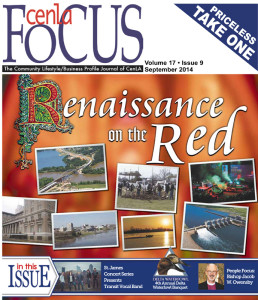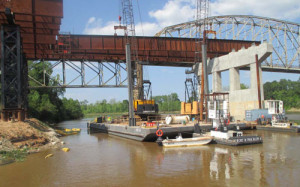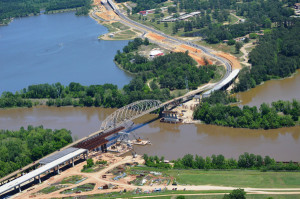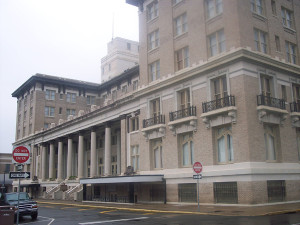
The opening of the J. Bennett Johnston Waterway (Red River) to navigation to Central Louisiana in 1990 brought and continues to bring development to our area. The project opened navigation to the Caddo-Bossier area in 1995. The project was made possible with additional funding through LaDOTD Port Priority Program and the Red River Waterway Commission, along with assistance from the Louisiana Economic Development and the local Central Louisiana Economic Development Alliance teams. In addition to providing new businesses to the Central Louisiana area, the J. Bennett Johnston Waterway has developed economic growth in the recreational area, providing a great natural resource for fishing, boating, camping and other recreational activities for the citizens of Cenla.

TRS has been at the port since 1998, and still has a presence at the port, shipping aggregate through the port as well as providing towing service to many of the users on the Red River. Private companies in Central Louisiana shipping on the Red River include Cleco, Pine Bluff Sand and Gravel, and Luhr Bros. Along with the users at the Port of Alexandria, these companies will ship over 2,000,000 tons on the Red River in 2014.
One of the most exciting companies to come to the Cenla area in many years is Coolplanet. Coolplanet is based out of Denver, Colorado, and are developers of small scale bio refineries which convert non-food biomass into gasoline, jet fuel and soil enhancing biochar. The location of the plant at the Port of Alexandria will serve as a showcase facility. The technology of this plant is the first of its kind in the United States. The location of this plant provides access to an abundance of renewable biomass feedstock, the ability to load their products into barges, rail cars and trucks. The project should provide approximately 125 construction jobs and 40 new permanent jobs. Construction is underway with expected startup of the facility is January 2016. Total cost of the project is estimated at $70,000,000 with private investment of $56 million.
The Red River Waterway Commission (RRWC) is a political subdivision of the State of Louisiana created in 1968, and is the local sponsor for the U.S. Army Corps of Engineers (USACE) J. Bennett Johnston Waterway (Red River Waterway) Navigation Project. The RRWC boundaries include seven Northwest and Central Louisiana parishes: Caddo, Bossier, Red River, Natchitoches, Grant, Rapides and Avoyelles; and, currently five ports operating along the Red River Waterway.

The RRWC is also pleased to report the findings of a December 2013 update on the Economic Impact of the Red River Waterway performed by LSU Professor Emeritus of Economics, Dr. Loren C. Scott of Loren C. Scott & Associates, Inc. The update statistically, empirically, and professionally confirms the positive impacts from the Red River Waterway. The RRWC, working together with others along the Red River Waterway, has brought over $7.1 billion to the 7-parish region it serves. Outstanding as that dollar amount is, when adjusted for inflation and put into 2013 dollars, the figure jumps to almost $9.9 billion. Said another way, ignoring the impacts of casinos, the Red River Waterway region benefited with over $32.00 of new state and federal spending, over $47.00 of new business sales, and over $16.00 of new household earnings, for every $1.00 of property tax collected.
By making the Red River Waterway navigable, new industries have been attracted to the region. In most cases, the newly attracted industries actually use the river to ship inbound or outbound cargo. Others do not directly use the river but still benefit from water-compelled rates (i.e., they use the option of barge transportation to get more favorable rates from other modes of transportation).
The RRWC has also developed and maintains twenty recreation areas along the Red River Waterway with five located in the Alexandria-Pineville Area. In cooperation with the City of Alexandria, improvements are being planned at the Alexandria Levee Park with the addition of a comfort station that includes restroom facilities, concession sale area and a “green room” for performers at an estimated cost of $550,000.
A note of concern is warranted regarding Giant Salvinia (Salvinia molesta). This aquatic fern, native to Brazil, is destructively invasive and a threat to the Red River Waterway and other bodies of water throughout the United States. It can double in biomass in as little as 2 to 3 days and is extremely detrimental to aquatic life, potentially threatening navigation along the Red River Waterway. The RRWC is actively engaged in fighting Giant Salvinia on the Red River Waterway, as well as, conducting independent research on various methods of control at its Aquatic Research Center (ARC) in Lena. In addition to its own research, the RRWC collaborates with and hosts Giant Salvinia research underway by Stephen F. Austin State University (SFA) at the ARC. The RRWC will continue its work addressing this matter and collaborating with local, state, and federal agencies.
What was once considered an unpredictable river is now a dynamic and dependable thoroughfare for commerce, recreation, and region-wide economic development. With its prime location, the Red River Waterway remains a top choice for industrial and commercial businesses, visitors, and major fishing events. Recent developments include a $1 billion project from CLECO near the Port of Alexandria, a $900M project by Benteler Steel at the Caddo-Bossier Port, and anticipated projects totaling to $170 million from Cool Planet Energy Systems at the Ports of Alexandria and Natchitoches, as well as, the 2009 and 2012 BASS Bassmaster Classics and the 2013 FLW Forrest Wood Cup, with over $50 million of economic impact.
The Red River Waterway is a proven and valuable resource, representing achievement and success on many levels: engineering, construction, navigation, flood control, recreation, commerce, industry, community, and economy. The RRWC will continue raising public awareness, identifying and developing opportunities for increased and enhanced lockages and tonnages, economic development, and recreational use. RRWC will continue working with the existing ports, carriers, shippers, agencies, and other users of the Red River Waterway to support them in their missions. Together we will continue protecting and delivering a higher quality of life and value to our communities, state, region, and nation!

The State is currently spending $82.6 million to replace the old O.K. Allen Bridge with twin two-lane bridges. DOTD says traffic should be rerouted from the old bridge by early 2015, with both spans completed by the summer of 2016.
While the crossing of the Red River is the major feature of the project, it is by no means the whole project. The project also features nearly 8,000 feet of four-lane divided roadway with connections to several major local streets on the Pineville side, and an interchange on the west bank connecting US 71/165 to I-49 and Third Street in Alexandria. Additionally, on the east end of the project, is a 1,220 foot long bridge crossing the Kansas City Southern Railroad, in front of “Rebel Hill” by Pineville High School’s football stadium. This will include new interchanges for better access to the Pineville Municipal Airport and Red River Waterway Recreation area.
Pineville Mayor Clarence Fields likes what both areas could mean economically. “We are really excited to see what happens with Highway 71/165 once the four-lane expansion is complete. That roadway has become a vital corridor to the growth of business and industry we’ve experienced, as well as to the stability and growth at Camp Beauregard,” he explains. “Now, we will have an opportunity to strengthen that, plus grow those areas that have been waiting for the 4-laning to be built. Plus you have 400-plus acres of Central State Hospital property that will become available for development in the near future and improved access to Buhlow Lake, our airport and the recreation area and it all adds up to a ton of opportunities for Pineville and all of Central Louisiana.”
Meanwhile, Pineville has been working with the City of Alexandria to explore how both sides of the river can benefit from Riverfront development. “We have had numerous conversations with the City of Alexandria on how we can work to revitalize both our downtown areas. The key to both is our Riverfronts. We must work together to bring more business and more opportunity back to our Main Streets,” Mayor Fields explains.
One initiative that could help with that is the legalization of alcohol in “restaurants only” last fall. It is no secret that, without it, established national chains will not come, and most thriving retail establishments have national restaurants that anchor their success.
Mayor Fields is confident that it’s only a matter of time before Cenla sees more movement on the Riverfront: “We have spoken with a handful of developers who see great potential along the Riverfront and would work to bring something unique to Central Louisiana. A rising tide lifts all boats and we believe that working together, the future is very bright between our River Cities.”
When Jacques Roy was elected mayor of Alexandria in 2006, he assured citizens that Alexandria was at a crossroads, noting the path to progress meant embracing change and soliciting the community, not government, to forge the future of the City. Since that day, the adiminstration has set about building a stronger Alexandria through targeted infrastructure investment and quality-of-life initiatives to create a more vibrant city. The downtown was a large part of this vision.
First, the mayor and his team created a massive infrastructure project making improvements in the city through the SPARC program. Downtown, plans were developed for a new community and technical college, which placed this region on the road to a stronger, healthier economic future and better equipped workforce for building resident capacity and attracting new businesses. “The single most important investment we can make is in education,” Mayor Roy explains. “Education is what feeds a community for life. Alexandria is making that investment in partnership with others to move our Downtown Community College Initiative and its effect on our economy, our families, and our quality of life will be felt for generations.”
The secondary impact from these investments–the college, infrastructure, hotels and tourism components–will further fuel downtown revitalization and the city’s rebirth and renewal. Just as in other SPARC corridors, stakeholders in the private sector already see the potential and are relocating downtown, making plans to be involved downtown, or are investing in other ways in Alexandria—with at least two new restaurants underway in downtown right now.
In addition, the mayor touts the long-awaited completion of the downtown hotels initiative and commitment to refurbish an already wonderful asset in the Alexandria Riverfront Center. With these initiatives, “Downtown Alexandria Now!” is fully launched and local stakeholders have taken up the gauntlet to see to fruition the revitalization of downtown Alexandria. “Downtown Alexandria Now!” is a part of the economic engine that is pumping life back into not just Alexandria’s downtown but the region as well.

To bring the City’s downtown back to a vibrancy not seen in decades, the mayor’s team initially focused on underutilized convention assets and two major downtown hotels—the historic Hotel Bentley and the Alexander Fulton Inn—incenting them back into commerce. These actions create a solid base from which to court convention business back downtown and provide the hospitality anchor needed to make the Alexandria Riverfront Convention Center a most desired place for conventions, expositions, and conferences. The Riverfront Center soon will undergo a $700,000 facelift.
As part of a yet-to-be-announced initiative and successor to the SPARC program, the Alexandria Riverfront Levee Amphitheatre is slated for immediate major improvements, including a “green room” and bathrooms. These improvements mark the beginning of the Red River Improvement Venture for Econo-Recreation, hopefully planned in coordination with Pineville’s downtown and river plans. This plan involves recreation improvements to our riverfront designed to support private economic investment on a large and powerful scale, working in conjunction with our other initiatives to make “Downtown Alexandria Now!” a reality. In this vision, simply making more recreation investments, while increasing our quality of life and enjoyment of the riverfront, is less desirable than creating opportunities for market-driven sustainable success.
The RIVER Act will build on these successes. “The plans being vetted fundamentally change the riverfront area while using the existing investments wisely,” Roy explains. “The plans are designed to create economic investments by the private sector, and are realistic first steps to growth in river-related economics and further recreation enjoyment, as opposed to unrealistic pie in the sky promises. Announcements without proper planning and realistic assessments degrade public trust; I hope with SPARC, our recreation rebirth, the Community College Initiative, and our other projects, people see we are serious and can move the needle positively for quality of life here at home.”
A healthy, vibrant downtown is one of the hallmarks of growing, dynamic metropolitan areas. Because of a number of decisions and investments made over the course of time, the downtown areas of Alexandria and Pineville have new hope and new potential.
The buzz that can be felt in downtown Alexandria now is also a direct product of the renovation of the Bentley Hotel by Mike Jenkins. Along with the Louisiana Technical College, these two major projects are bringing significant investments and momentum downtown.

Meanwhile, the Cultural Arts District provides a much-needed downtown anchor and active center for the arts sector in Central Louisiana. The Alexandria Museum of Art, the Rapides Foundation building, the Kress Theater, the Coughlin Saunders Theater, the River Oaks Square Arts Center, the Arna Bontemps Museum and the T.R.E.E. House Children’s Museum populate the Cultural Arts District as it stretches towards I-49. Nearby the Alexandria History Museum adds another rich facet to the downtown experience.
Non-profit organizations such as the Chamber of Commerce, CLEDA, the Arts Council of Central Louisiana, the United Way, the Rapides Foundation, the Rapides Symphony Orchestra and the Central Louisiana Community Foundation make important contributions to downtown as well. City, parish, federal and state agencies also are at home downtown, ranging from Alexandria City Hall to the Rapides School Board offices to the Greater Alexandria Economic Development Authority.
Rapides Regional Medical Center already dominates the landscape of the Medical District downtown, and the hospital has just announced plans for a $12.5 million expansion. LSUA’s Allied Health campus and a variety of other medical and healthcare entities are also located within the Medical District footprint.
Looking back just a few short years, however, it is two small businesses that have served as symbols of downtown Alexandria’s rebirth. Both are sole proprietorships owned by canny, hardworking entrepreneurs. Tamp & Grind opened about four years ago and has built a loyal following among artists, photographers, students, faculty and the business community alike. More recently, Word of Mouth Café followed in its footsteps and has also built a strong following for their Monday to Friday luncheon venue.
Across the river, the opening of alcohol availability in restaurants and other factors are stirring up exciting discussions of downtown and riverfront development. All of Central Louisiana stands to benefit from a Renaissance on the Red.
Special thanks to Rich Dupree, Cynthia Jardon, Randy Walters, Robert Vinet, Ken Guidry, Deborah Randolph, Jim Clinton, the City of Alexandria, the City of Pineville, and the Red River Waterway Commission, for their contributions to this story.









